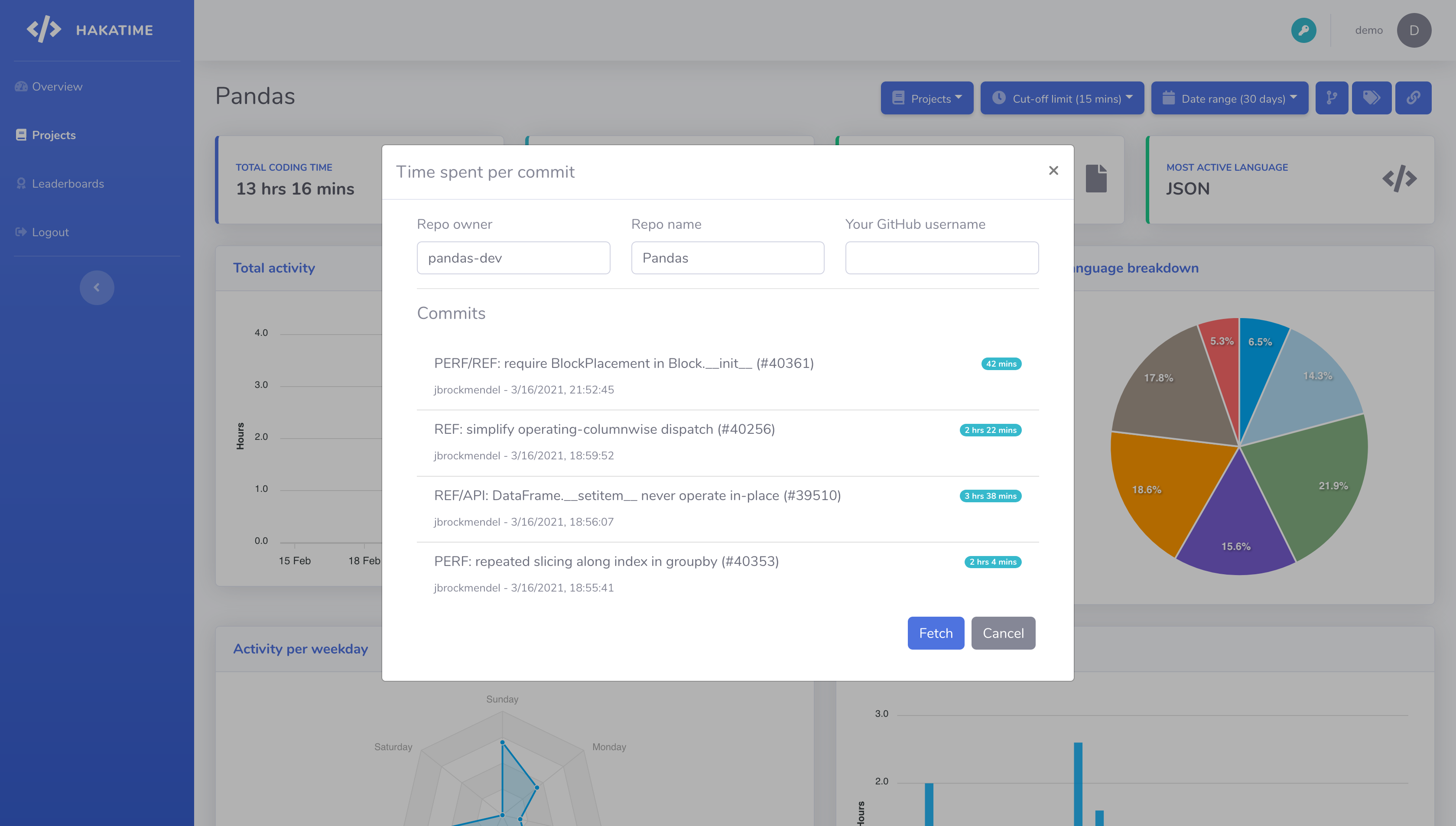Hakatime is a server implementation of Wakatime. You can use it as a self-hosted alternative.
It comes together with a dashboard which provides a graphical representation of the collected data.
- Import Wakatime activity using an API token and a range of dates.
- See time spent on Github commits.
- Forward incoming heartbeats to another Wakatime compatible server (e.g
wakatime.com) - Group projects together with tags (e.g
#work,#personal) and view their aggregated statistics. - User registration & login through the UI.
- Leaderboards for all the users of the instance.
- Badge generation for a project that displays that total amount of hours spent for a configurable
time period.
- Global and per project charts
- Breakdown by project or language.
- Breakdown by day of week and hour of the day.
- Timeline of activity for a configurable time-frame.
- Total time spent per file.
- API token management & generation.
There is demo instance with fake data here.
Use demo as username and demodemo as password to login. You can create an API token and try sending your
data.
After you've generated a new API token from Hakatime's UI, update your ~/.wakatime.cfg file like below:
[settings]
api_key=<generated_token>
# e.g api_url=https://hakatime-demo.mtx-dev.xyz/api/v1/users/current/heartbeats.bulk for the demo instance.
api_url=<hakatime_instance_url>/api/v1/users/current/heartbeats.bulkThe file's location might be different depending on your system and editor. Please consult the client docs for further information.
You can use the following docker-compose setup for testing locally or an actual
deployment. Change HAKA_BADGE_URL to match the actual external endpoint of your
instance.
Deploying on ARM is also possible using the mujx/hakatime:latest-arm or mujx/hakatime:v1.5.0-arm image or the dedicated
Dockerfile (Dockerfile.arm) to build the image.
version: "3"
services:
server:
container_name: hakatime
image: mujx/hakatime:v1.5.0
environment:
# DB settings.
HAKA_DB_HOST: haka_db
HAKA_DB_PORT: 5432
HAKA_DB_NAME: test
HAKA_DB_PASS: test
HAKA_DB_USER: test
# Server settings.
# Fill out this field if the api is behind another path (e.g behind a reverse proxy).
# This will adjust the Set-Cookie path for all the /auth related API calls.
HAKA_API_PREFIX: ""
# Update this with the external endpoint that you use to access hakatime.
HAKA_BADGE_URL: "http://localhost:8080"
HAKA_PORT: 8080
HAKA_SHIELDS_IO_URL: "https://img.shields.io"
HAKA_ENABLE_REGISTRATION: "true" # Toggle after you've created your account.
# Number of hours after which inactive browser sessions will expire (login required).
HAKA_SESSION_EXPIRY: "24"
HAKA_LOG_LEVEL: "info" # Control the verbosity of the logger.
HAKA_ENV: "dev" # Use a json logger for production, otherwise key=value pairs.
HAKA_HTTP_LOG: "true" # If you want to log http requests.
GITHUB_TOKEN: "<token>" # If you want to retrieve time spent per commit. No extra scope is required.
# Add the following variables if you want to forward any received heartbeats to another
# Wakatime compatible server.
HAKA_REMOTE_WRITE_URL: "https://wakatime.com/api/v1/users/current/heartbeats.bulk"
HAKA_REMOTE_WRITE_TOKEN: "<token>"
ports:
- "127.0.0.1:8080:8080"
haka_db:
container_name: haka_db
image: postgres:12-alpine
environment:
POSTGRES_DB: test
POSTGRES_PASSWORD: test
POSTGRES_USER: test
volumes:
- deploy_db_data:/var/lib/postgresql/data
volumes:
deploy_db_data: {}To start all the services run:
$ docker-compose -f ./docker-compose-deploy.yml upand navigate to http://localhost:8080 to access the dashboard.
Requirements:
- GHC (tested with 8.8 & 8.10)
- libpq (PostgreSQL bindings)
- cabal-install (Build system for Haskell)
cabal build
cabal run exe:hakatime -- runThe output files will be located at dashboard/dist.
Requirements:
- Node.js & npm
cd dashboard
npm install
npm run prodhakatime :: v1.5.0
Usage: hakatime COMMAND
Wakatime server implementation
Available options:
-h,--help Show this help text
Available commands:
create-token Create a new auth token
create-user Create a new user account
run-migrations Apply pending database migrations
run Start the Server
Any kind of contribution is greatly appreciated. This could be:
- Bug fixes
- Suggesting/Implementing new features
- UI/UX improvements/suggestions
- Code refactoring





